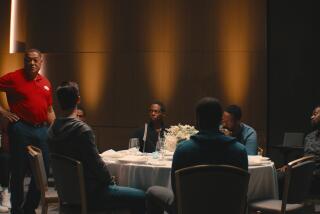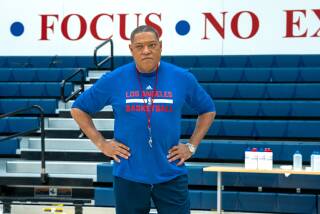Judd Apatowâs â30 For 30â documentary explores the ups and downs of Mets greats Darryl Strawberry and Doc Gooden
Reporting from NEW YORK â Judd Apatow was at a post-screening talk recently for his new movie, âDoc & Darryl,â when asked what it was about the making of his documentary, about the once-great New York Metsâ Dwight Gooden and Darryl Strawberry, that most surprised him.
âI thought,â he said dryly, âit was going to be a lot more uplifting.â
Viewers might be equally taken aback. The baseball tale, which Apatow co-directed with veteran documentarian Michael Bonfiglio, on its surface seems like one more celebration of those glorious 1980s Mets teams, or at least a traditional comeback story of its two principals.
But what they found was much darker and more complicated. Rather than offer a familiar story of redeemed superstars, âDoc & Darrylâ uncovers a pair of men who captivated a nation and then, almost simultaneously, began an epic battle with their demons.
When audiences tune in to watch the movie â which ESPN will air Thursday as part of its â30 for 30â series â they likely will come away not only appreciating the depth possessed by a pair of vintage athletes but possibly seeing all their heroes in a more ambiguously human light.
âItâs a movie about stars, but itâs really about people who had a lot more downs than they had ups,â Apatow said in an interview here.
It’s a movie about stars, but it’s really about people who had a lot more downs than they had ups.
— Judd Apatow
Viewers also will have their expectations confounded of a director who, after more than a decade chronicling the raunchy and the lovelorn in feature films and television, has, with his first documentary, located a new arena in which to focus his gaze.
The basics of the Dwight âDocâ Gooden and Darryl Strawberry stories are widely known. The duo formed the twin towers of baseball during those Reagan days, two poor kids who ascended, then descended, the sports-media mountain. They were Straw and the Doc, the lanky Angeleno with the sweet swing and the soft-spoken Floridian with the arm of gold. Following each other into the majors by one season in the early 1980s, they each would go on to win rookie of the year awards and lead the Mets to the 1986 World Series title.
The more salacious details of their lives, particularly Strawberryâs battle with drugs and alcohol, have been well-documented in the tabloids. Their humanity has not.
Relying partly on a conceit of a reunion in a Queens, N.Y., diner (the film is more revealing when the subjects are speaking in separate on-camera interviews), âDoc & Darrylâ examines a wealth of private thoughts and experiences. This is particularly true in the case of Gooden, who, the film tactfully suggests, continues to struggle with cocaine addiction.
It looks, for instance, at the hurlerâs deep regret about missing the 1986 victory parade because of a post-World Series drug bender.
It examines Strawberryâs multiple battles with cancer and their complicated relationship with his drug use. (The slugger also played for the hometown Dodgers, including a successful 1991 season and two erratic years that followed.)
It offers a diner moment in which Gooden, now 51, confronts Strawberry, now 54, in his characteristically low-key way, about a charge that Strawberry had called him out to Mets management. (Strawberry denies it, unconvincingly.)
It covers the starsâ controversial relationship with women â including a domestic-abuse arrest for Strawberry and a rape allegation against Gooden that did not lead to charges. (Whether that topic is dealt with sufficiently or with sufficient criticism likely will be a matter of viewer debate.)
It highlights a moment when teammate Keith Hernandez first suspected Goodenâs drug problem and the sense of foreboding it evoked in him. (Hernandez provides the team perspective; Jon Stewart the fan one.)
And the movie makes clear how, as much as the pressure â and party culture â of 1980s New York exacerbated tendencies in young men of whom (too) much was expected, the roots of their problems were laid much earlier.
âItâs clear this began in childhood,â said Bonfiglio, alluding to both subjectsâ alcoholic and abusive fathers. âIf they had gone to play in Cincinnati, they probably still would have had addiction issues. New York just amplified everything.â
Said Apatow of what he and his partner uncovered: âWe thought this would really be a look how they climbed out of it. As it went on, we became more and more aware of how recent their troubles were.â
After five features that culminated in last summerâs âTrainwreck,â Apatow is moving on to new directorial pastures. He is making at least two more documentaries: a piece on the Southern-fried hipster band the Avett Brothers that he recently completed shooting, and a movie about Garry Shandling, based in part on the late comedianâs diaries.
âI only have so many stories from my own life. At some point, I have to tell other peopleâs stories,â Apatow said, half-joking, referring to the autobiographical beats in scripted films such as âThis Is 40â and âFunny People.â
But there may be a more specific reason for his decision to make a movie like âDoc & Darryl.â Much as with his recent narrative work, the film examines the lives of men whoâve reached a certain plateau of success and must contend with what to do next, with how to define themselves.
I only have so many stories from my own life. At some point, I have to tell other people’s stories.
— Judd Apatow
Apatow also makes a similar suggestion in this film as he does in many of his narrative films: that the devil lies within.
âI always tell people who say I donât have enough villains in my movies is that itâs hard enough to get through the day without villains, and I think thatâs shown clearly in a lot of documentaries.â
Apatow was not intent on making a sports documentary. But an ESPN executive reached out to him on Twitter to gauge his interest in a â30 for 30â project. Soon, he and Bonfiglio (the director of âYou Donât Know Bo,â about multi-sport athlete Bo Jackson) were talking about a Mets movie. Apatow, 48, had grown up on Long Island a fan of the team â in junior high, he interviewed beloved Mets centerfielder Mookie Wilson â and so the two set about courting the stars.
Though Apatow said Strawberry and Gooden have seen and liked the movie, neither was at the New York premiere recently â possibly because it was hard for them to relive their pasts.
âItâs a story that goes to a lot of dark places, and not one where you necessarily want to make yourself available for a whole bunch of interviews,â said Jonathan Dahl, the ESPN executive who oversees â30 for 30.â
As many entries in the series have done, âDoc & Darrylâ demonstrates that all good sports stories are human stories. Anchoring the film is the âAmyâ-ish idea that, beyond simple schadenfreude, dismissals or even pity, celebrity addiction should stir more complex feelings about human fragility.
And hovering above âDoc & Darrylâ is a melancholic air of what might have been â both for these two men and their single-championship team â had they not been bedeviled by disease or had they and others better succeeded in defeating it.
âWe could have made a story about the crazy â86 Mets and all the stuff that went on,â Dahl said. âBut that was less interesting to us. Dwight and Darrylâs prodigious talent makes you want to explore what happened. These two saviors â why didnât they save the Mets? Why didnât they save themselves?â
Twitter: @ZeitchikLAT
ALSO:
Boom! Studios to publish WWE comic books
The Los Angeles Rams go âHollywoodâ in upcoming E! reality TV series
Why âO.J.: Made in Americaâ might be the first television show to win an Oscar
More to Read
The complete guide to home viewing
Get Screen Gab for everything about the TV shows and streaming movies everyoneâs talking about.
You may occasionally receive promotional content from the Los Angeles Times.







